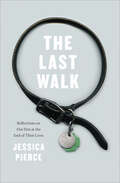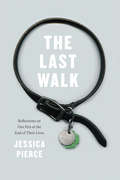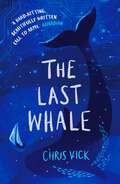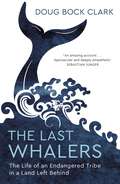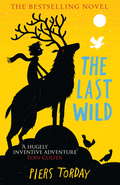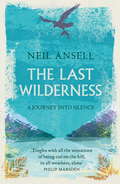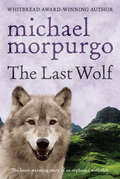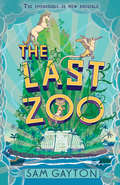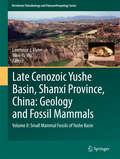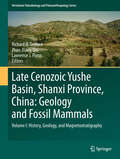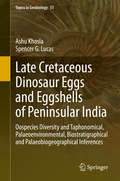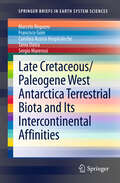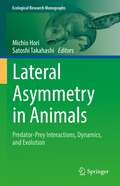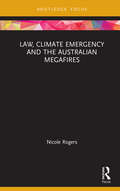- Table View
- List View
The Last Walk: Reflections on Our Pets at the End of Their Lives
by Jessica PierceFrom the moment when we first open our homes—and our hearts—to a new pet, we know that one day we will have to watch this beloved animal age and die. The pain of that eventual separation is the cruel corollary to the love we share with them, and most of us deal with it by simply ignoring its inevitability. With The Last Walk, Jessica Pierce makes a forceful case that our pets, and the love we bear them, deserve better. Drawing on the moving story of the last year of the life of her own treasured dog, Ody, she presents an in-depth exploration of the practical, medical, and moral issues that trouble pet owners confronted with the decline and death of their companion animals. Pierce combines heart-wrenching personal stories, interviews, and scientific research to consider a wide range of questions about animal aging, end-of-life care, and death. She tackles such vexing questions as whether animals are aware of death, whether they're feeling pain, and if and when euthanasia is appropriate. Given what we know and can learn, how should we best honor the lives of our pets, both while they live and after they have left us? The product of a lifetime of loving pets, studying philosophy, and collaborating with scientists at the forefront of the study of animal behavior and cognition, The Last Walk asks—and answers—the toughest questions pet owners face. The result is informative, moving, and consoling in equal parts; no pet lover should miss it.
The Last Walk: Reflections on Our Pets at the End of Their Lives
by Jessica PierceFrom the moment when we first open our homes—and our hearts—to a new pet, we know that one day we will have to watch this beloved animal age and die. The pain of that eventual separation is the cruel corollary to the love we share with them, and most of us deal with it by simply ignoring its inevitability. With The Last Walk, Jessica Pierce makes a forceful case that our pets, and the love we bear them, deserve better. Drawing on the moving story of the last year of the life of her own treasured dog, Ody, she presents an in-depth exploration of the practical, medical, and moral issues that trouble pet owners confronted with the decline and death of their companion animals. Pierce combines heart-wrenching personal stories, interviews, and scientific research to consider a wide range of questions about animal aging, end-of-life care, and death. She tackles such vexing questions as whether animals are aware of death, whether they're feeling pain, and if and when euthanasia is appropriate. Given what we know and can learn, how should we best honor the lives of our pets, both while they live and after they have left us? The product of a lifetime of loving pets, studying philosophy, and collaborating with scientists at the forefront of the study of animal behavior and cognition, The Last Walk asks—and answers—the toughest questions pet owners face. The result is informative, moving, and consoling in equal parts; no pet lover should miss it.
The Last Walk: Reflections on Our Pets at the End of Their Lives (Emersion: Emergent Village Resources For Communities Of Faith Ser.)
by Jessica PierceFrom the moment when we first open our homes—and our hearts—to a new pet, we know that one day we will have to watch this beloved animal age and die. The pain of that eventual separation is the cruel corollary to the love we share with them, and most of us deal with it by simply ignoring its inevitability. With The Last Walk, Jessica Pierce makes a forceful case that our pets, and the love we bear them, deserve better. Drawing on the moving story of the last year of the life of her own treasured dog, Ody, she presents an in-depth exploration of the practical, medical, and moral issues that trouble pet owners confronted with the decline and death of their companion animals. Pierce combines heart-wrenching personal stories, interviews, and scientific research to consider a wide range of questions about animal aging, end-of-life care, and death. She tackles such vexing questions as whether animals are aware of death, whether they're feeling pain, and if and when euthanasia is appropriate. Given what we know and can learn, how should we best honor the lives of our pets, both while they live and after they have left us? The product of a lifetime of loving pets, studying philosophy, and collaborating with scientists at the forefront of the study of animal behavior and cognition, The Last Walk asks—and answers—the toughest questions pet owners face. The result is informative, moving, and consoling in equal parts; no pet lover should miss it.
The Last Whale
by Chris VickFrom killers to conservationists, Carnegie-shortlisted Chris Vick tells the story of three generations of the Kristensen family, their history as whale hunters and later their mission to save the great whales and our planet.Summer, the Present Fiery and fierce, computer geek and eco-activist, Abi is holidaying with her grandmother on an island off the Norwegian coast. Having developed and befriended an AI device, Moonlight, she hopes to organise a global protest. On the island, she learns her great-grandfather rejected the family's whaling livelihood, instead creating the first whale song recording. Inspired by him, Abi and Moonlight translate the whales' songs and discover their stories. Whales are under threat, their numbers rapidly dwindling. Abi is determined to help.Autumn, 30 years later The world's ecosystems are collapsing. There is no sight or sound of whales. Abi, her daughter, Tonje, and a now almost conscious Moonlight live on an isolated island in the Atlantic. They search for any sign of whales, but so far there is only silence.Winter, the Future Tonje's search was not in vain. Despite climate crisis and the threat of extinction, there is always hope for the future, as nature and technology combine in a captivating, action-packed adventure with a powerful environmental call to arms.
The Last Whalers: The Life of an Endangered Tribe in a Land Left Behind
by Doug Bock Clark'I absolutely loved this magnificent book' Sebastian Junger'A monumental achievement' Mitchell Zuckoff'[An] immersive, densely reported and altogether remarkable first book ... The Last Whalers has the texture and colouring of a first-rate novel' New York TimesAt a time when global change has eradicated thousands of unique cultures, The Last Whalers tells the stunning inside story of the Lamalerans, an ancient tribe of 1,500 hunter-gatherers who live on a volcanic island so remote it is known by other Indonesians as "The Land Left Behind." They have survived for centuries by taking whales with bamboo harpoons, but now are being pushed toward collapse by the encroachment of the modern world.Award-winning journalist Doug Bock Clark, who lived with the Lamalerans across three years, weaves together their stories with novelistic flair to usher us inside this hidden drama. Jon, an orphaned apprentice whaler, strives to earn his harpoon and feed his ailing grandparents. Ika, Jon's indomitable younger sister, struggles to forge a modern life in a tradition-bound culture and realize a star-crossed love. Ignatius, a legendary harpooner entering retirement, labors to hand down the Ways of the Ancestors to his son, Ben, who would rather become a DJ in the distant tourist mecca of Bali.With brilliant, breathtaking prose and empathetic, fast-paced storytelling, Clark details how the fragile dreams of one of the world's dwindling indigenous peoples are colliding with the irresistible upheavals of our rapidly transforming world, and delivers to us a group of families we will never forget.
The Last Wild: Book 1 (The Last Wild Trilogy #1)
by Piers TordayAS SEEN ON BBC'S COUNTRYFILEFrom the winner of the Guardian Children's Fiction PrizeThis is a story about a boy named Kester. He is extraordinary, but he doesn't know that yet. All he knows, at this very moment, is this: 1. There is a flock of excited pigeons in his bedroom. 2. They are talking to him. 3. His life will never be quite the same again... A captivating animal adventure destined to be loved by readers of all ages.
A Last Wild Place: Seasons in the Wilderness
by Mike TomkiesWhen Mike Tomkies moved to a remote cottage on the shores of Loch Shiel in the West Highlands of Scotland, he found a place which was to provide him with the most profound wilderness experience of his life. Accessible only by boat, the cottage he renamed ‘Wildernesse’ was to be his home for many years, which he shared with his beloved German Shepherd, Moobli.Centred on different landscape elements – loch, woodlands and mountains –Tomkies describes the whole cycle of nature through the seasons in a harsh and testing environment of unrivalled beauty. Vivid colours and sounds fill the pages – exotic wild orchids, the roar of rutting stags, the territorial movements of foxes, otters and badgers, an oak tree being torn apart by hurricane-force gales. Nothing escapes his penetrating eye.His extraordinary insights into the wildlife that shared his otherwise empty territory were not gained without perseverance in the face of perilous hazards, and the difficulties and challenges of life in the wilderness are a key part of this remarkable book.
The Last Wilderness: A Journey into Silence
by Neil AnsellNeil Ansell's THE LAST WILDERNESS is a mesmerising book on nature and solitude by a writer who has spent his lifetime taking solitary ventures into the wild. For any readers of the author's previous book, DEEP COUNTRY, Robert Macfarlane's THE OLD WAYS or William Atkins THE MOOR.Shortlisted for the 2018 Wainwright Golden Beer Book PrizeShortlisted for the 2018 Highland Book Prize 'Ansell has the rare skill of combining vividly the intimacy of detail and the astonishing grandeur of this North West coastline of Scotland. Through his keen eyes we look again at the familiar with a sense of wondrous revelation' Madeleine Bunting 'Beautiful...a testimony to reticent courage' Daily MailThe experience of being in nature alone is here set within the context of a series of walks that Neil Ansell takes into the most remote parts of Britain, the rough bounds in the Scottish Highlands. He illustrates the impact of being alone as part of nature, rather than outside it.As a counterpoint, Neil Ansell also writes of the changes in the landscape, and how his hearing loss affects his relationship with nature as the calls of the birds he knows so well become silent to him.
The Last Wolf
by Jim CrumleyThe best nature writer working in Britain today' - Los Angeles Times Book Review In The Last Wolf, Jim Crumley explores the place of the wolf in Scotland - past, present and future - and challenges many of the myths that have been regarded for centuries as biological fact. Bringing to bear a lifetime's immersion in his native landscape and more than twenty years as a professional nature writer, Crumley questions much of the written evidence on the plight of the wolf in light of contemporary knowledge and considers the wolf in today's world, an examination that ranges from Highland Scotland to Devon and from Yellowstone in North America to Norway and Italy, as he pursues a more considered portrait of the animal than the history books have previously offered. Within the narrative, Crumley also examines the extraordinary phenomenon of wolf reintroductions physically transforming the landscapes in which they live that even the very colours of the land change under the influence of teeming grasses, flowers, trees, butterflies, birds, and mammals that flourish in their company, Crumley makes the case for their reintroduction into Scotland with all the passion and poetic fervour that has become the hallmark of his writing over the years. This is an elegant, erudite and imaginative account that readdresses the place of the wolf in modern Scotland.
The Last Wolf
by Mini GreyOnce upon a time, Little Red set off into the woods to catch a wolf . . .But the woods aren't all they seem - and are there even any wolves left? Mini Grey re-imagines the classic Little Red Riding Hood fable in an entirely new way. Can Little Red help her new friends in need and recover the wild days of the past?This is a powerful, moving and funny picture book which will have children and adults revisiting its exquisite pages time and time again, and discussing the important message it holds. From the award-winning author/illustrator of The Adventures of the Dish and the Spoon, The Pea and the Princess and Biscuit Bear.
The Last Wolf (Rollercoasters Ser.)
by Michael MorpurgoMichael Morpurgo has created a sweeping and dramatic story in the time of Bonnie Prince Charlie. This spellbinding tale is complemented perfectly by Michael Foreman's illustrations.Robbie McLeod and a wolf cub, both orphaned, venture far from their birthplace, a land of rebellious fighters and vicious redcoats. There is little constancy in Robbie's adventurous life, save for the companionship of his wolf. But when at last Robbie finds a place where he can peacefully make his home, he knows in his heart that the wolf must find his own natural home too . . .
The Last Zoo
by Sam GaytonPia lives in a zoo in the middle of the Pacific Ocean with her parents (both ghosts), several old and cranky genies, a devil, and two young angels. She spends her days trimming genie-beards, trying to avoid being tricked into selling her soul, and waiting for the angels to make a miracle big enough to save the world.Then the angels go missing. Can she solve the riddles of the mysterious haloes the angels have left behind? Is the zoo’s devil really trying to help her? And what does this all have to do with her best friends, the Rekkers? Pia needs to solve the mystery fast, because everything around her seems to be ending: her friendships, her childhood, and maybe even the world itself.
Late Cenozoic Yushe Basin, Shanxi Province, China: Volume II: Small Mammal Fossils of Yushe Basin (Vertebrate Paleobiology and Paleoanthropology)
by Lawrence J. Flynn Wen-Yu WuThis volume focuses on small mammal fossils from extinct Asian faunas of about 1 to 7 million years ago in North China. These played a role in the emergence of vertebrate paleontology as a modern science in that country. This second volume of the sub-series Late Cenozoic Yushe Basin, Shanxi Province, China: Geology and Fossil Mammals in the Vertebrate Paleobiology and Paleoanthropology book series deals with a rich microfauna fossil record; megafauna follow in subsequent volumes. This research on Yushe Basin fossils provides a view of changes in northeast Asian terrestrial faunas during the Late Neogene, and therefore is a key to the biochronology for a vast part of the continent. The faunas recovered by the multinational team working in this region represent changes in small mammal communities of the Yushe Basin, revealed on a finer time scale that has not been achieved previously. Detailed systematic studies on small mammal groups proceeded under the care of specialists are outlined in the chapters of this volume. Paleontologists, ecologists and evolutionary biologists will find this book appealing.
Late Cenozoic Yushe Basin, Shanxi Province, China: Volume I:History, Geology, and Magnetostratigraphy (Vertebrate Paleobiology and Paleoanthropology)
by Richard H. Tedford, Zhan-Xiang Qiu and Lawrence J. FlynnThe Late Cenozoic Yushe Basin, Shanxi Province, China embodies the bulk of our knowledge on successions of terrestrial vertebrates in the northern part of East Asia. Everything we know about Asian mammals of the last 6 million years has a historical basis in the documentation of the geology of Yushe. This volume introduces the basin in its geological setting, describes the succession of fossiliferous strata, and shows how it is dated. It develops an unsurpassed level of precision for its age control. Geological maps and stratigraphic sections provide the backbone for individual studies to follow on varied fossil groups. The volume explores the history of exploration of the last century in Yushe Basin and places development of paleontology there into the context of the birth of the modern epoch of science in China.
Late Cretaceous Dinosaur Eggs and Eggshells of Peninsular India: Oospecies Diversity and Taphonomical, Palaeoenvironmental, Biostratigraphical and Palaeobiogeographical Inferences (Topics in Geobiology #51)
by Ashu Khosla Spencer G. LucasThis book documents analyses of the Late Cretaceous dinosaur nesting sites of the Lameta Formation at Jabalpur, Districts Dhar and Jhabua, Madhya Pradesh; Districts Kheda and Panchmahal (Gujarat); and the Pisdura, Dongargaon and Pavna sectors in the Chandrapur Districts of Maharashtra, which are exposed in India along an east-west and central axis. In this work, special emphasis has been given to the dinosaur nesting sites of the east-central Narbada River region, including its regional geology. The work was undertaken to provide detailed information concerning dinosaur eggs, eggshell fragments, nests and clutches found in the Lameta Formation of peninsular India. Prior to the present work there had been no detailed review of systematic work on the taxonomy, and of micro- and ultrastructural studies of dinosaur eggs and eggshells from the Lameta Formation. The study documents the field and laboratory investigations that facilitated the reconstruction of the morphotaxonomy, models for the burial pattern of eggs and eggshells, taphonomic implications,and the palaeoenvironmental context and palaeoecological conditions during the Late Cretaceous at the time of the extrusion of the Deccan traps, which may have been partly responsible for the extinction of the dinosaurs. The need to follow a parataxonomic classification for Indian dinosaur eggs and eggshell types is very apparent, and this book addresses this aspect in some detail. The emphasis on the application of parataxonomic schemes is based on the description of new oospecies and their comparison with previously known forms. The present work has led to the recovery of numerous nests, many collapsed eggs and hundreds of dinosaur eggshell fragments from the localities situated near the east, west and central Narbada River regions. It will be of interest to academics and professional palaeontologists, and all students of dinosaurs.
Late Cretaceous/Paleogene West Antarctica Terrestrial Biota and its Intercontinental Affinities (SpringerBriefs in Earth System Sciences)
by Marcelo Reguero Francisco Goin Carolina Acosta Hospitaleche Tania Dutra Sergio MarenssiOne of the most intriguing paleobiogeographical phenomena involving the origins and gradual sundering of Gondwana concerns the close similarities and, in most cases, inferred sister-group relationships of a number of terrestrial and freshwater vertebrate taxa, e.g., dinosaurs, flying birds, mammals, etc., recovered from uppermost Cretaceous/ Paleogene deposits of West Antarctica, South America, and NewZealand/Australia. For some twenty five extensive and productive investigations in the field of vertebrate paleontology has been carried out in latest Cretaceous and Paleogene deposits in the James Ross Basin, northeast of the Antarctic Peninsula (AP), West Antarctica, on the exposed sequences on James Ross, Vega, Seymour (=Marambio) and Snow Hill islands respectively. The available geological, geophysical and marine faunistic evidence indicates that the peninsular (AP) part of West Antarctica and the western part of the tip of South America (Magallanic Region, southern Chile) were positioned very close in the latest Cretaceous and early Paleogene favoring the “Overlapping” model of South America-Antarctic Peninsula paleogeographic reconstruction. Late Cretaceous deposits from Vega, James Ross, Seymour and Snow Hill islands have produced a discrete number of dinosaur taxa and a number of advanced birds together with four mosasaur and three plesiosaur taxa, and a few shark and teleostean taxa.
Latency Strategies of Herpesviruses
by Janos Minarovits Eva Gonczol Tibor Valyi-NagyThis volume provides an overview of the latency strategies developed during the estimated 200,000 year-long coevolution of Alpha-, Beta- and Gammaherpesvirinae and their host species. While the main emphasis is on herpesviruses infecting humans, relevant cases if herpesviruses infecting animals are covered as well. Special emphasis is given to results on molecular mechanisms regulating latent promoters of herpesvirus genomes and signals and molecular pathways resulting in reactivation of latent viral genomes.
Latent Herpes Virus Infections in Veterinary Medicine: A Seminar in the CEC Programme of Coordination of Research on Animal Pathology, held at Tübingen, Federal Republic of Germany, September 21–24, 1982 (Current Topics in Veterinary Medicine #27)
by G. Wittmann R. M. Gaskell H. J. RzihaThis seminar referred to latent herpes virus infections in veterinary medicine, with emphasis on the domestic animals. The phenomenon of latency is of particular importance in veterinary medicine because it can jeopardize the successful control and eradication of diseases such as Aujeszky's disease and infectious bovine rhinotracheitis, diseases which are often the cause of great economic losses. For this reason, the Commission of the European Communities (CEC) realized the importance of summarizing the present state of knowledge on latent herpes virus infections in veterinary medicine. A seminar was therefore organized by the Federal Research Institute for Animal Virus Diseases in Ttibingen, Federal Republic of Germany, from September 21 to 23, 1982, as a part of the 'Animal Pathology Programme' of the CEC. The seminar was attended by 50 participants not only from the countries of the CEC, and 38 papers were selected for presentation. In veterinary medicine, more intensive investigations on the latency of animal herpes viruses have only relatively recently been initiated. In contrast, great efforts have been made for many years to elucidate latency in human and primate herpes viruses, and consequently the most considerable advances have been made in this field. Some of the most experienced scientists working on both systems were therefore invited. As a result, this seminar was the first occasion on which scientists from different countries and faculties investigating herpes virus latency had the opportunity to present and exchange their latest results. The.
Lateral Asymmetry in Animals: Predator-Prey Interactions, Dynamics, and Evolution (Ecological Research Monographs)
by Satoshi Takahashi Michio HoriThis book presents the latest research findings on the laterality of fish and other animals. It describes all aspects of lateral asymmetry, including ecology, morphology, behaviour, dynamics of lefty and righty morphs, genetics and evolution, through field observations, experiments and modeling. Lateral asymmetry in scale-eating cichlids gives a simple and beautiful example of negative frequency-dependent selection and resulting oscillation of lefty and righty morph frequencies. Lateral dimorphism is found not only in scale-eaters but in all orders of fish, shrimps and cuttlefish. Lateral asymmetry interacts between species through "cross-predation." Contrary to fish, lateral asymmetry in snails acts as, in most cases, positive frequency-dependent selection and provides deep insights into speciation. Especially, snakes eating righty snails facilitate speciation of lefty snails.As a collaboration work of field ecologists and theoretical biologists, this book covers a variety of topics on lateral asymmetry, which are consistently related to predation. The topics include behavioral ecology, population dynamics, physiology, evolution, genetics, development, learning and neuroscience, statistics, with the subjects of fish, shrimp, prawn, and crayfish, crab, cuttlefish, and snake and snail. Chapters cover new research results such as cuttlefish laterality dynamics, interaction between laterality of snails and snakes, evolution of laterality genetic system, and statistical analysis of laterality oscillation. Readers will appreciate the simplicity and beauty of lateral asymmetry and its profound impact on ecology and evolution.
Lavin's Radiography for Veterinary Technicians - E-Book
by Marg Brown Lois BrownMake sure you understand and know how to use the very latest diagnostic imaging technology with Lavin’s Radiography for Veterinary Technicians, 6th Edition! All aspects of imaging – including production, positioning, and evaluation of radiographs – are combined into this comprehensive text. All chapters have been thoroughly reviewed, revised, and updated with vivid color equipment photos, positioning drawings, and detailed anatomy drawings. From foundational concepts to the latest in diagnostic imaging, this text is a valuable resource for students, technicians, and veterinarians alike!More than 1000 full-color photos and updated radiographic images visually demonstrate the relationship between anatomy and positioning.UNIQUE! Non-manual restraint techniques including sandbags, tape, rope, sponges, sedation and combinations improve your safety and radiation protection.UNIQUE! Comprehensive dental radiography coverage gives you a meaningful background in the dentistry subsection of vet radiography.Increased emphasis on digital radiography, including quality factors and post-processing, keeps you up-to-date on the most recent developments in digital technology.Broad coverage of radiologic science, physics, imaging and protection provide you with foundations for good technique.Objectives, key terms, outlines, chapter introductions and key points help you organize information to ensure you understand what is most important in every chapter.Color anatomy art created by an expert medical illustrator help you to recognize and avoid making imaging mistakes.Check It Out boxes provide suggestions for practical actions that help better understand content being presented.Points to ponder boxes emphasize information critical to performing tasks correctly.Key points boxes help you to review critical content presented in the radiographic positioning chapters.NEW! All chapters have been reviewed, revised and updated to present content in a way that is easy to follow and understand.NEW! Updated radiation protection chapter focuses on the importance of safety in the lab. NEW! Additional popular diagnostic information includes MRI/PET and CT/PET scans. NEW! Coverage of Sante’s Rule that clearly explains the mathematical process for creating a technique chartNEW! Chapters on Dental Imaging and Radiography, Quality Control, and Testing and Artifacts combines existing content with updates into these important parts of radiography.
Law, Animals and Toxicity Testing: The Case of the Laboratory Mouse (ISSN)
by Anne M. WordsworthDrawing on our growing knowledge of animal cognition, this book provides a critical analysis of the use of animals in the legal regime and the practice of toxicity testing.Although animal abuse has become a major issue, animal testing remains largely in the shadows, even though it involves substantial cruelty. Toxicity testing, in particular, imposes considerable pain, suffering and ultimately death on those laboratory animals – often mice – chosen to demonstrate the characteristics of chemicals and their commercial potential. This book documents and critically analyzes the animal protection laws of the European Union, the United States and Canada. It not only examines the tests themselves and the suffering they inflict on animals but also exposes the failure of both the testing and the toxicity laws to effectively protect human health and the environment. Finally, the book takes up the potential of alternative non-animal testing methods to replace the current regimen and to reduce current damage to health and the environment.This book will be of interest to scholars and researchers in the fields of animal studies, environmental law and sociolegal studies, as well as activists and others with an interest in ethics and animal rights.
Law, Animals and Toxicity Testing: The Case of the Laboratory Mouse (ISSN)
by Anne M. WordsworthDrawing on our growing knowledge of animal cognition, this book provides a critical analysis of the use of animals in the legal regime and the practice of toxicity testing.Although animal abuse has become a major issue, animal testing remains largely in the shadows, even though it involves substantial cruelty. Toxicity testing, in particular, imposes considerable pain, suffering and ultimately death on those laboratory animals – often mice – chosen to demonstrate the characteristics of chemicals and their commercial potential. This book documents and critically analyzes the animal protection laws of the European Union, the United States and Canada. It not only examines the tests themselves and the suffering they inflict on animals but also exposes the failure of both the testing and the toxicity laws to effectively protect human health and the environment. Finally, the book takes up the potential of alternative non-animal testing methods to replace the current regimen and to reduce current damage to health and the environment.This book will be of interest to scholars and researchers in the fields of animal studies, environmental law and sociolegal studies, as well as activists and others with an interest in ethics and animal rights.
Law, Climate Emergency and the Australian Megafires
by Nicole RogersThis book addresses the ways in which the Black Summer megafires influenced the development of climate narratives throughout 2020. It analyses the global pandemic, and its ensuing restrictions, as a countervailing force in the production of such narratives. Lives and properties were lost in the spring and summer of 2019 and 2020, when catastrophic bushfires burnt through millions of hectares of mainland Australia. Nearly three billion native animals died. And for millions of Australians, and others worldwide, it was through the Australian megafires that the global climate emergency became tangible, concrete, no longer a comfortably deferred, albeit problematic abstraction which could be consigned to future generations to deal with. This book explores the legal and other implications of new understandings of climate emergency arising from the fires, and the emergence of a hierarchy of emergencies as the pandemic came to dominate global and domestic political discourses. It examines narratives of culpability, and legal avenues for seeking retribution from government and big fossil fuel emitters. It also considers the impact of the fires on the burgeoning phenomenon of climate activism, particularly in Australia, and the ways in which pandemic restrictions curtailed such activism. Finally, the book reflects on the fires through the lenses offered by climate fiction, and apocalyptic fiction more generally, in order to consider how these shape, and might shape, our responses to them. This important and timely book will appeal to environmental lawyers and socio-legal theorists; as well as other scholars and activists with interests in climate change and its impact. It is recommended for anyone concerned about current and future climate disasters, and the shortcomings in legal, political and popular responses to the climate crisis.
Law, Climate Emergency and the Australian Megafires
by Nicole RogersThis book addresses the ways in which the Black Summer megafires influenced the development of climate narratives throughout 2020. It analyses the global pandemic, and its ensuing restrictions, as a countervailing force in the production of such narratives. Lives and properties were lost in the spring and summer of 2019 and 2020, when catastrophic bushfires burnt through millions of hectares of mainland Australia. Nearly three billion native animals died. And for millions of Australians, and others worldwide, it was through the Australian megafires that the global climate emergency became tangible, concrete, no longer a comfortably deferred, albeit problematic abstraction which could be consigned to future generations to deal with. This book explores the legal and other implications of new understandings of climate emergency arising from the fires, and the emergence of a hierarchy of emergencies as the pandemic came to dominate global and domestic political discourses. It examines narratives of culpability, and legal avenues for seeking retribution from government and big fossil fuel emitters. It also considers the impact of the fires on the burgeoning phenomenon of climate activism, particularly in Australia, and the ways in which pandemic restrictions curtailed such activism. Finally, the book reflects on the fires through the lenses offered by climate fiction, and apocalyptic fiction more generally, in order to consider how these shape, and might shape, our responses to them. This important and timely book will appeal to environmental lawyers and socio-legal theorists; as well as other scholars and activists with interests in climate change and its impact. It is recommended for anyone concerned about current and future climate disasters, and the shortcomings in legal, political and popular responses to the climate crisis.
Laws of the Sea: Interdisciplinary Currents
by Irus BravermanLaws of the Sea assembles scholars from law, geography, anthropology, and environmental humanities to consider the possibilities of a critical ocean approach in legal studies. Unlike the United Nations’ monumental Convention on the Law of the Sea, which imagines one comprehensive constitutional framework for governing the ocean, Laws of the Sea approaches oceanic law in plural and dynamic ways. Critically engaging contemporary concerns about the fate of the ocean, the collection’s twelve chapters range from hydrothermal vents through the continental shelf and marine genetic resources to coastal communities in France, Sweden, Florida, and Indonesia. Documenting the longstanding binary of land and sea, the chapters pose a fundamental challenge to European law’s “terracentrism” and its pervasive influence on juridical modes of knowing and making the world. Together, the chapters ask: is contemporary Eurocentric law—and international law in particular—capable of moving away from its capitalist and colonial legacies, established through myriad oceanic abstractions and classifications, toward more amphibious legalities? Laws of the Sea will appeal to legal scholars, geographers, anthropologists, cultural and political theorists, as well as scholars in the environmental humanities, political ecology, ocean studies, and animal studies.
